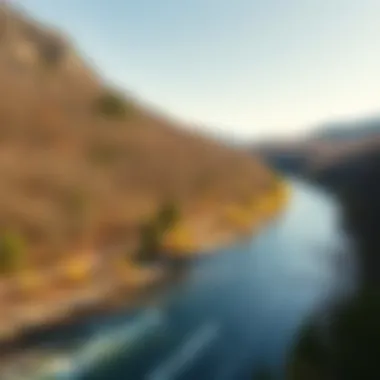Scenic Drives in West Virginia: An In-Depth Guide


Intro
West Virginia, often celebrated for its stunning landscapes and vibrant ecosystems, offers a plethora of scenic drives that traverse its remarkable natural beauty and rich cultural history. From the towering Appalachian Mountains to the tranquil rivers snaking through lush valleys, each route is a tapestry of breathtaking views and intricate geological formations. For those with a keen interest in forestry and ecology, these drives not only present opportunities for recreation but also serve as a living classroom, shedding light on the importance of environmental stewardship and sustainable practices.
As we navigate the winding roads of West Virginia, we will uncover the significance of its forest ecosystems, examine sustainable forestry practices fostering local conservation efforts, and celebrate the communities playing a crucial role in preserving this natural heritage. Be it seasoned forestry professionals or academic enthusiasts, this guide aims to provide a comprehensive understanding of how these scenic routes encapsulate the state's commitment to ecological balance and cultural richness.
Forest Ecology and Biodiversity
Importance of Forest Ecosystems
West Virginia's forests are a vital component of its ecosystem. They host a vast array of flora and fauna, serve as a critical habitat for wildlife, and act as key players in the carbon cycle. The dense woodlands contribute to soil stability, water purification, and air quality. An impressive aspect of these forests is their ability to offer recreational opportunities while supporting biodiversity.
Key Benefits of Forest Ecosystems:
- Biodiversity: Forests are home to diverse species of plants and animals, some of which are endemic, meaning they are found nowhere else on earth.
- Climate Regulation: The trees absorb carbon dioxide, helping to mitigate the effects of climate change.
- Resource Provision: Forest ecosystems provide timber, clean water, and medicinal plants, all essential for local economies and human well-being.
Flora and Fauna in Woodlands
The rich tapestry of biodiversity within West Virginia's woodlands tells a compelling story. Towering oaks and vibrant wildflowers create stunning contrasts throughout the seasons. Many species, such as the Eastern Box Turtle and the American Redstart, find refuge here. The intricate interactions between various species make these ecosystems resilient and adaptive.
Some Key Species to Look Out For:
- Trees: Red Maple, White Oak, and Eastern Hemlock
- Wildlife: Black Bears, White-tailed Deer, and various bird species like the Scarlet Tanager
"The forests of West Virginia are not only a treasure trove of biodiversity but are also crucial in the fight against climate change and habitat preservation."
Sustainable Forestry Practices
Techniques for Responsible Management
In recent years, the conversation around sustainable forestry practices has gained significant momentum. West Virginia is committed to embracing such methods, ensuring that the rich woodlands are managed responsibly. Techniques such as selective logging, clear-cutting alternatives, and reforestation play a vital role in maintaining ecological balance while supporting economic interests.
Important Techniques Include:
- Selective Logging: Harvesting specific trees to minimize ecological disruption.
- Reforestation: Planting trees to restore ecosystems after logging activities.
Certification Schemes and Standards
Another avenue guided by sustainability is the certification of forest products. Programs such as the Forest Stewardship Council and Sustainable Forestry Initiative endorse responsible management practices. These certifications are not just badges of honor; they signify a commitment to ecological integrity, community welfare, and economic viability in the forestry sector.
Community Engagement and Stewardship
Role of Local Communities
The communities surrounding West Virginia's scenic routes are pivotal to conservation efforts. It is their intimate understanding of the land, passed down through generations, that adds depth to the stewardship narrative. Community-driven initiatives often combine both economic and environmental goals, ensuring that locals thrive while preserving their natural heritage.
Volunteer Opportunities for Engagement
Engagement doesn’t stop at community efforts. Numerous organizations and local groups welcome volunteers to help in conservation projects. Opportunities abound, whether it's tree planting, trail maintenance, or educational outreach programs aimed at spreading awareness about environmental issues. Getting involved is a chance to contribute positively while gaining insight into West Virginia’s majestic landscapes.
In sum, West Virginia’s scenic drives beckon not just for their aesthetic allure but as pathways to understanding the intricate relationships within forest ecosystems, sustainable forestry practices, and the community engagement that signifies a commitment to keeping the state’s natural treasures preserved for generations to come.
Prelude to West Virginia's Scenic Drives
West Virginia is often hailed as the Mountain State, and it lives up to this moniker in the most picturesque ways. When it comes to experiencing the beauty of this region, scenic drives hold a special place in the hearts of both locals and visitors. Each road twists and turns through rolling hills, dense forests, and expansive river valleys, offering glimpses of the rich biodiversity that defines this land.
The importance of exploring these scenic routes goes beyond the breathtaking views they provide; they offer a chance to connect with nature, history, and culture. For those interested in forestry, ecology, or simply the joy of outdoor experiences, these drives are not just pathways but narratives of the land itself. By taking the time to appreciate the drive rather than just the destination, one can uncover the underlying stories each path has to tell.
The Allure of Scenic Roadways
The magnetic pull of scenic roadways is something right out of a storybook. When you saunter along West Virginia’s routes, every curve and elevation change showcases nature’s artistry. The leaves, when in full autumnal garb, transform the landscape into a kaleidoscope of colors, enticing travelers to pull over and snap a few photos or savor the moment over a warm cup of coffee from a roadside stand.
Moreover, these drives facilitate a deeper understanding of local cultures. From the small towns steeped in history to the unique festivals that dot the calendar, the roads interweave with the fabric of daily life in West Virginia. Exploring these scenic byways allows for encounters with the state’s hospitable inhabitants, who can share stories, provide insights into their crafts, and perhaps even point out hidden gems off the beaten path. In essence, driving through West Virginia becomes a journey that amply rewards both the eyes and the soul.


An Overview of West Virginia's Landscape
West Virginia’s landscape is a beautiful contradiction. It cradles mountains that are rugged and majestic while also preserving serene valleys and meandering rivers below. Appalachian Mountains dominate the horizon, characterized by their ancient rock formations and lush forests. The timberline swathes the hills in a blanket of green, with streams bubbling everywhere like nature’s symphony.
Interestingly, the unique geological history of this state translates into a variety of ecosystems that thrive along the scenic drives. For example, high-altitude sections of routes might be lined with spruce and fir, while lower elevations give way to oaks, maples, and hickories. These transitions offer not just a feast for the eyes, but also significant ecological opportunities as they serve as habitats for countless species.
Travelers can also experience the diverse wildlife habitats; deer, black bears, and a myriad of birds may cross one’s path. Recognizing and understanding these facets can enrich a drive, creating more than just a moment of leisure but an engaging activity for ecologists, students of the environment, and everyday adventurers alike.
"Every road tells a different story, waiting for those willing to listen as they navigate the heart of Appalachia."
The Historical Context of Scenic Routes
Understanding the historical context of scenic routes is essential to appreciate their role not only in transportation but also in connecting people to the landscape, culture, and heritage of West Virginia. These roadways are more than mere paths to travel; they represent a tapestry of stories, where each twist and turn harkens back to a different era, each stop along the way reveals a chapter in the state's rich narrative. Moreover, they withhold invaluable insights into how our ancestors navigated and shaped the land, making them vital for studies in conservation and community engagement.
Early Development of Roads
The evolution of roads in West Virginia is intimately tied to its settlement patterns and economic growth. Early paths, often mere trails used by native tribes, laid the groundwork for what would become more structured routes. The colonization period saw the establishment of irregularly shaped routes connecting settlements, primarily for trade. Over time, as communities formed, the demand for better connectivity grew. The completion of the National Road in the early 19th century marked a significant milestone—it allowed for smoother travel across the Appalachian region.
The advent of the railroads later on further magnified the necessity for well-planned roadways. As goods could be transported more efficiently via rail, local economies thrived. Yet, the roads were never abandoned; instead, they transformed into scenic routes, inviting travelers to partake in the stunning vistas along the way. This gradual enhancement of pathways essentially blended function with beauty, laying the groundwork for the scenic drives we celebrate today.
Cultural Influences on Route Design
Cultural elements played a pivotal role in the design of scenic routes in West Virginia. Though primarily functional, these roads were also creations of their time, reflecting the values and aesthetics of different societies. For instance, as tourism began to surface as a prominent industry in the late 19th century, certain routes were crafted specifically to highlight the breathtaking landscapes that West Virginia possesses. The roads were designed to flow with the natural topography, an idea that resonated strongly in the Arts and Crafts movement of that era.
Distinctive features emerged, such as overlooks and rest areas, which invite travelers to take a moment and absorb their surroundings. The idea of creating spaces to appreciate natural beauty was not just about convenience; it was about fostering a connection to the land and encouraging an appreciation for nature. These cultural influences are still present today. Modern developments in route planning often consider environmental sustainability and community value, ensuring that the scenic routes of West Virginia serve as conduits for both transport and education about local flora, fauna, and heritage.
"Roads represent not just means of travel; they are testimonies to how we perceive, interact with, and cherish our environment."
Top Scenic Drives to Discover
Scenic drives in West Virginia are not just routes from point A to point B; they are an experience that offers breathtaking views, rich history, and a deeper connection to the natural world. This section delves into some of the most remarkable drives that the state has to offer. By exploring these routes, visitors not only enjoy the landscapes but also gain insights into ecological significance and cultural heritage. Every twist and turn of these drives reveals unique stories waiting to be unraveled.
The Highland Scenic Highway
Route Highlights
The Highland Scenic Highway is a crown jewel that stretches approximately 43 miles amidst lush greenery and sweeping mountain vistas. What sets this route apart is its elevation which reaches over 4,000 feet, allowing travelers to behold some of the most panoramic views in the region. The road serves as a portal to the Monongahela National Forest, which is rich in biodiversity and ecological variety. Among the highlights are the stunning views at the Cranberry Glades Botanical Area, where visitors can discover unique flora that thrives in the region's wetlands. Navigating this highway during autumn unveils an explosion of color, making it a favorite among photographers and nature lovers alike. However, the journey can involve steep gradients, requiring careful driving, especially in inclement weather conditions.
Ecological Significance
The Highland Scenic Highway isn't just a pleasant drive; it plays a crucial role in the preservation of diverse ecosystems. This roadway runs through habitats that support a myriad of plant and animal species, many of which are endemic to West Virginia. The highway emphasizes the importance of these ecosystems in maintaining biodiversity. It's also a vital corridor for wildlife movement, connecting different habitats. With its well-preserved landscapes, it serves as an example of how human activity can coexist with nature. The unique microclimates along the route foster various plant communities, making it a hotspot for ecologists and botanists alike to study and engage with the environment.
Access Points
Accessing the Highland Scenic Highway is straightforward, with entry points located off U.S. Route 219 and West Virginia Route 150. These access points are strategically positioned, providing easy entry to and from the scenic route, making it convenient for both locals and tourists. Well-marked signs guide travelers to scenic overlooks and parking areas. However, it’s important to note that certain sections of the highway can become narrow, and in winter months, snowfall can lead to closed sections, making it essential for visitors to check road conditions before setting out.
US Route
Surrounding Flora and Fauna
US Route 219 meanders through some of West Virginia's most vibrant and diverse ecological zones. This drive is characterized by its remarkable forests filled with hardwood trees, which serve as a habitat for various wildlife species. Drivers might spot deer grazing off the roadside or the occasional fox darting through the underbrush. This variation in habitats allows for a rich array of flora and fauna, from wildflowers blooming in the spring to vibrant autumn foliage. The local bird species add a melodic backdrop to the drive, making it not just a visual feast but also a symphony of sounds. Preservation of these areas is crucial, given the threats posed by urbanization and climate change.
Historical Landmarks
US Route 219 is not solely about nature; it weaves a narrative rich in history. Along the drive, travelers will stumble upon historical landmarks, including the impressive Greenbrier Hotel and the charming town of Marlinton. Each landmark tells a story, connecting past and present, and often includes interpretive signs that provide context to the significance of the structures or locales. For those interested in history, this drive offers ample stopping points to explore and absorb the local heritage while providing context to the landscapes that cradled these communities.
Visitor Amenities
Along US Route 219, various amenities cater to visitors, making it a user-friendly drive. Gas stations, picnic areas, and local diners serve as perfect breaks for those looking to stretch their legs or grab a bite. Furthermore, some towns along the route have visitor centers that offer additional information on the surrounding areas, including maps, brochures, and tips on local attractions. While some amenities are modern, there remains a rustic charm to them that resonates with the essence of West Virginia.
The Seneca Skyway
Mountain Vistas
The Seneca Skyway presents captivating mountain vistas that unfold as one travels along its paths. This scenic drive elevates travelers to new heights, quite literally, with views that stretch as far as the eyes can see. Notably, the observation points along the way, such as the observation deck at Spruce Knob, reward visitors with breathtaking panoramas of the surrounding valleys and nearby peaks. The ever-changing landscape offers photographers and nature enthusiasts a wealth of opportunities to capture the shifting light and weather conditions, but one should be prepared for the occasional cloud cover that can obstruct views.


Wildlife Observation
When it comes to wildlife observation, the Seneca Skyway is unparalleled. Home to a plethora of wildlife, spotting creatures such as black bears, wild turkey, and countless bird species is common along the drive. Dedicated observation areas with information boards educate visitors on the local ecosystems and species. These areas often encourage respectful wildlife watching practices, including keeping a safe distance and not feeding the animals. However, as with any location, patience is key; glimpsing these animals can frequently be a matter of time and luck.
Best Times to Visit
Timing a visit to the Seneca Skyway can greatly enhance the experience. Spring brings new life and vibrant blossoms, while autumn showcases a kaleidoscope of colors. Summer, with its verdant greens, creates a lush, dense atmosphere. Each season offers something unique, and the drive is best enjoyed during weekdays to avoid the crowds. However, one must remain aware of weather conditions, as fog can be a frequent visitor, especially in colder months, impacting visibility.
New River Gorge Scenic Byway
Adventure Opportunities
The New River Gorge Scenic Byway is well-known for adventure seekers. This route is more than just a picturesque drive; it is a doorway to a plethora of outdoor activities. The area offers world-class white-water rafting, rock climbing, and hiking trails that cater to all skill levels. Families, thrill-seekers, and solo adventurers find solace here, with enough to keep adrenaline junkies busy year-round. However, potential visitors should also consider safety measures and should always check local guides or outfitters for reliable information and recommendations.
Geological Features
Driving through the New River Gorge, you’ll encounter fascinating geological formations that tell a tale of natural history. The gorge itself, carved by the relentless flow of the New River, showcases stunning cliffs and rock formations that are of great interest to geologists and casual travelers alike. Each bend reveals layers of sediment that articulate the time scale of the Earth’s formation. Intent observers can notice distinct striations and formations that, while not overly technical, pique curiosity and invite further exploration into geological sciences.
Conservation Efforts
Significant conservation efforts are underway in the New River Gorge area, aimed at sustaining its environments and ecosystems. Organizations work hand-in-hand with local communities to promote sustainable tourism that respects the natural landscape. Educational programs highlight the importance of protecting these delicate areas while fostering awareness through community engagement. These initiatives serve as a reminder that tourism and conservation can coexist, yet it requires vigilance and proactive steps from both visitors and locals alike.
To know more about the conservation efforts, visit National Park Service.
Exploring West Virginia's scenic drives opens up avenues to experience nature, history, and community. With each route, there are tales waiting to be discovered, helping to forge connections not just to the land, but to the unique culture that enriches this beautiful state.
Ecological Importance of Scenic Drives
Scenic drives in West Virginia serve as more than just routes for travelers; they embody vital corridors of ecological significance, offering a glimpse into the diverse landscapes and natural resources of the region. These roads not only enhance the aesthetic appreciation of the breathtaking views but also play a pivotal role in preserving important habitats and ecosystems. This section delves into two critical aspects of the ecological importance of these scenic drives: habitat preservation and biodiversity.
Habitat Preservation
The need for habitat preservation has never been more critical. As human activity expands, various species face threats from habitat loss. Scenic drives help to safeguard these areas by connecting vast sections of wilderness and allowing ecosystems to flourish. Many roads wind through nature preserves and parks, restricting development and protecting native flora and fauna. For instance, the Highland Scenic Highway traverses forests that are home to black bears, deer, and a multitude of migratory birds. By maintaining these thoroughfares, we ensure that these species have the room they need to thrive and adapt.
Moreover, scenic drives frequently provide essential resources, such as clean water and food, that support wildlife populations. They become focal points for conservation efforts as organizations and local governments recognize their role in preserving landscapes. Engaging in habitat preservation has broader environmental implications, often leading to improved air and water quality in surrounding areas.
"Scenic byways act as lifelines for both natural habitats and the communities that depend on them."
Biodiversity and Scenic Roads
The rich tapestry of biodiversity found along West Virginia's scenic roads is both a marvel and a treasure. A diverse array of plant and animal life can adapt and thrive within the various ecosystems that these roads traverse. For example, the terrain along the New River Gorge Scenic Byway varies from lush valleys to steep cliffs, making it an ideal environment for both temperate species and unique adaptations.
Biodiversity is not merely a natural asset; it is critical for ecological stability and resilience. It maintains ecosystem services, which include pollination, soil health, and disease regulation. The diverse habitats along these scenic drives also serve as living laboratories for education and research.
Visitors have an opportunity to observe rare species and unique plant communities that flourish due to the diverse topography of the area. Maintaining these routes with minimal disruption helps sustain these populations, allowing visitors and researchers alike to study and appreciate the intricacies of natural ecosystems.
In sum, the ecological significance of West Virginia's scenic drives is multifaceted, encompassing habitat preservation and biodiversity, essential for maintaining the health of the planet. These roads not only offer stunning views but also serve as a reminder of the rich natural heritage that deserves protection.
Visitor Considerations
When it comes to embarking on scenic drives in West Virginia, visitor considerations play a crucial role. These elements ensure that travelers can savor the beautiful landscapes while maintaining safety and being considerate of the environment. Understanding the importance of navigation, road conditions, and environmental respect can significantly enhance the experience for everyone involved.
Navigating the Routes
Safety Tips
Safety during your adventurous journeys is paramount. Considerations such as adhering to speed limits, being alert to changing weather conditions, and using turn signals can make a world of difference. Dense forests and winding roads in West Virginia can present unexpected challenges, so having proper safety protocols in place is essential. The key feature of these tips lies in their straightforward nature, making them accessible for all drivers, even those who may not be experienced on mountainous terrain.
A unique advantage of adhering to safety tips is the peace of mind it brings. Familiarizing oneself with emergency contact numbers and understanding the local wildlife may help mitigate risks. By prioritizing safety, travelers preserve not only their own well-being but also contribute to a smoother driving environment for others.
Road Conditions
Another crucial facet to consider is the road conditions on your chosen route. West Virginia offers an array of drives, each with varying levels of maintenance. Some roads are well-paved, while others may be less traveled and require more caution. This variety brings a certain charm, but one must be aware of potholes, gravel sections, and landslide debris, particularly after heavy rainfall. The importance of staying informed about these conditions cannot be overstated, as they directly impact safety and travel time.
Characteristics such as road signage and regular maintenance can enhance the driving experience. Being aware of where to find local updates or maps online—such as those available at WV.gov—can aid travelers in navigating these roads safely. It’s a bright idea to check before you set out.


Travel Recommendations
Planning which route to take isn’t just about the starting point and destination; it’s also about pacing your travels, the best times of day to drive, and which sites to visit along the way. To make the most of your journey, consider recommendations tailored for scenic drives in West Virginia. Early mornings or late afternoons are often ideal for driving, as the sunlight paints the landscape in golden hues. Avoiding peak tourist times can enhance your experience by lessening traffic and providing an opportunity to enjoy the scenery in solitude.
Utilizing local guides or apps that recommend scenic outlooks can transform an ordinary trip into an extraordinary adventure. Even though some routes may tempt you to rush through, the unique charm of stopping at roadside markets or historical sites is worth every minute. It allows one to absorb the true spirit of the region, supporting local economies and fostering authenticity.
Respecting the Environment
Leave No Trace Principles
Preserving the natural beauty of West Virginia while enjoying its scenic routes is crucial. The Leave No Trace principles are an essential aspect of this discussion, providing guidelines on minimizing impact when visiting natural areas. These principles include basics like disposing of waste properly, respecting wildlife, and staying on designated paths.
These principles champion responsible tourism and are a widely recognized choice for environmentally-minded travelers. The unique feature of adhering to these guidelines is that they promote conservation while still allowing for engagement with the environment. By practicing these principles, visitors not only enhance their experience but also protect the delicate ecosystems of West Virginia.
Community Involvement
Community involvement is another vital aspect of ensuring these scenic drives remain accessible and enjoyable. Engaging with local communities fosters a sense of belonging and encourages advocacy for the preservation of natural resources. Participating in local events or volunteer days can leave a positive imprint in the scenery and ensure that future generations can also enjoy these routes.
The feature of community involvement is its dual benefit; it connects visitors with local residents and deepens appreciation for the space they travel through. Active participation in local charities or environmental campaigns can enhance the overall driving experience, making it rich with connections and understanding.
Visitors of West Virginia’s scenic drives should remember: the journey is as important as the destination. Respect for the environment and the local community lead to a more fulfilling experience for everyone.
Cultural and Economic Impact
The cultural and economic implications of scenic drives in West Virginia are both significant and far-reaching. These roadways are not just paths through natural beauty, but also channels that connect communities, industries, and histories. They generate substantial economic activity while fostering a sense of identity and pride among local populations.
Tourism and Local Economies
Tourism is often hailed as one of the lifebloods of local economies, and when it comes to West Virginia, scenic drives play a pivotal role in attracting visitors. Travelers from near and far flock to experience the varied landscapes, from rolling hills and dense forests to stunning overlooks. Scenic routes like the Highland Scenic Highway and New River Gorge Scenic Byway lead the way in promoting the region’s natural treasures.
- Economic Benefits: These drives boost local businesses such as hotels, restaurants, and gas stations. Tourists tend to stop for food, stay overnight, or purchase crafts and souvenirs, all of which pump money into the local economies. For instance, the shops in the quaint towns along the US Route 219 report increased foot traffic each season, leading to greater sales and vitality in their communities.
- Job Creation: As tourism rises, so does the need for more jobs. Local employment opportunities flourish as businesses hire more staff to accommodate the influx of visitors. This boost can help ease regional unemployment rates and contribute to sustained economic growth.
- Community Development: Revenue from tourism is often reinvested into community projects, parks, and environmental initiatives, enhancing overall quality of life. These reinvestments open up fresh prospects for enhancement and maintenance of scenic drives, aligning economic interests with ecological stewardship.
"Scenic drives connect people not just to nature, but to the stories and experiences that define us."
Importance of Community Engagement
The significance of community engagement in relation to scenic drives is frequently underestimated. Local voices and experiences shape the authenticity of these routes, leading to a harmonious blend of culture and tourism. Engagement serves not only to uphold traditions but to ensure that local needs and aspirations are met.
- Cultural Heritage: Scenic drives often intersect with historic trails and sites, making it essential for communities to take a proactive stance in preserving and sharing these narratives. Local festivals, art shows, and cultural fairs are examples of how communities showcase their heritage, encouraging tourists to take part in and respect the local culture.
- Involvement in Decision-Making: When local populations participate in discussions regarding road maintenance and tourism initiatives, it leads to more thoughtful decision-making. They can provide insights into what works, what doesn’t, and how best to enhance the experience for both visitors and residents. This collaboration can bridge gaps between environmental, economic, and cultural needs, leading to well-rounded, sustainable tourism strategies.
- Volunteer Opportunities: Engaging community members in activities such as clean-up drives or conservation efforts fosters a strong sense of ownership over local landscapes. When individuals actively participate in caring for their environment, it cultivates respect and further promotes tourism as a means to preserve their unique rural charm.
Future of Scenic Drives in West Virginia
The future of scenic drives in West Virginia is increasingly crucial not just for tourism, but also for ecological stewardship, community development, and the preservation of natural beauty. As visitors flock to the state's winding roads flanked by rolling hills and lush forests, there is a growing recognition of the need to protect these landscapes from advancing industrialization and environmental degradation. Scenic routes serve as vital corridors for both wildlife and travelers, blending enjoyment with a deep responsibility toward the land.
Sustainability Initiatives
Sustainability is a hot topic, and rightly so. West Virginia's future scenic drives will hinge on innovative practices that minimize environmental impacts while maximizing visitor experiences.
- Infrastructure Improvements: Investments in eco-friendly road construction materials can significantly reduce carbon footprints. Using recycled materials for roadwork not only preserves existing resources but also ensures the endurance of scenic routes.
- Native Landscaping: Embracing native vegetation along these drives is beneficial in several ways. It reduces water consumption, supports local wildlife, and creates an aesthetically pleasing landscape that draws visitors. By prioritizing plants that are native to West Virginia, the local ecology thrives, reinforcing the region's natural heritage.
- Renewable Energy Sources: Installing solar panels at rest stops can provide power for amenities while lessening reliance on fossil fuels. This step not only aligns with sustainability efforts but also serves as an educational tool for visitors about renewable energy's role in conserving natural resources.
As the enthusiastic interest in outdoor travel grows, integrating these sustainability initiatives becomes a vital piece of the puzzle.
Preserving the Legacy
Preserving the legacy of West Virginia's scenic drives involves more than just maintaining the roads; it requires an active commitment to the history these pathways carry with them. Many of these routes were shaped by the culture and livelihoods of the region’s communities. Therefore, an understanding of their historical significance is essential.
- Community Engagement: Engaging local communities in preserving scenic drives fosters a sense of ownership. By involving residents in conservation initiatives, locals can share their stories and help shape the narrative of these routes, ensuring that culture is preserved alongside natural beauty.
- Educational Programs: By establishing educational programs that commemorate the history and significance of each drive, we encourage respect for these natural corridors. Workshops, guided tours, and informational signage can contribute to the understanding of geological forms, flora and fauna, as well as the cultural narratives intertwined with each route.
- Legislative Support: Ensuring that scenic drives receive protection through local and state legislation is fundamental. Policies that restrict development within certain distances of scenic roads contribute to financial support for maintenance and consistent funding for improvement.
The legacy of these drives will live on as long as we commit to their care, creating a harmonious balance between tourism, culture, and environmental responsibility.
The End
The beauty of West Virginia extends beyond its towering mountains and verdant valleys; it is carved into the very roads that meander through this enchanting landscape. The scenic drives detailed in this guide are not just routes from point A to point B; they are pathways that tell stories, evoke emotions, and encourage a deeper connection with nature.
The Enduring Appeal of West Virginia's Scenic Drives
These drives embody the spirit of exploration and a profound appreciation for the environment. Each turn reveals a breathtaking vista or a hidden gem, inviting travelers to pause and reflect on the natural wonders around them. The allure of these routes lies not only in their physical beauty but in their ability to foster a sense of peace and tranquility amidst the hustle and bustle of modern life. From the rolling hills of the Highland Scenic Highway to the rugged terrains along the New River Gorge, each drive offers unique experiences and opportunities for adventure.
Moreover, as conservationists and outdoor enthusiasts advocate for preserving these landscapes, it becomes clear that these drives serve as more than just picturesque backdrops. They are essential lifelines for local economies, driving tourism and supporting small businesses. By choosing to traverse these scenic routes, visitors contribute to the protection of the environment while enjoying its splendor.
"Every scenic drive in West Virginia is a reminder of our responsibility to protect what makes this state truly special."















